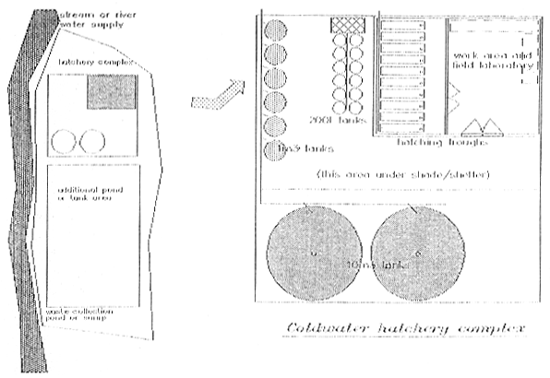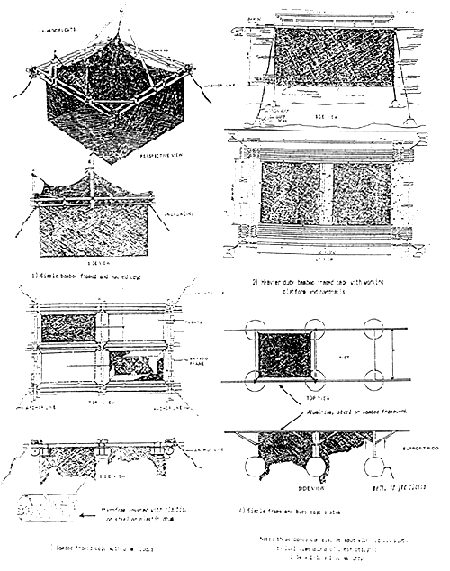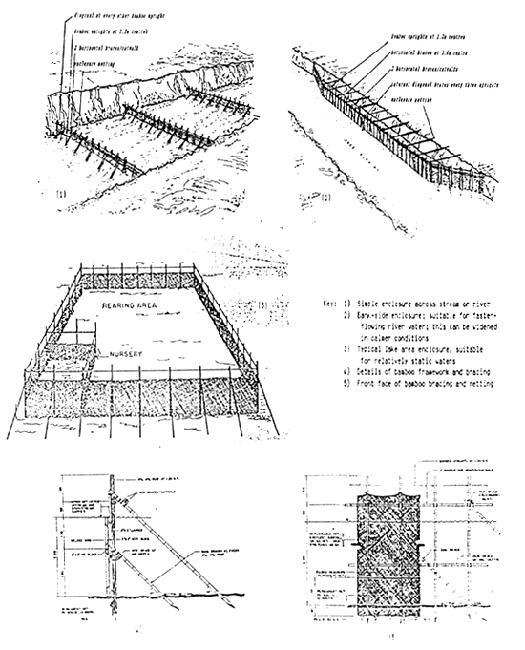For zone I (coldwater highland) species, the centre should ideally be located at an existing trout hatchery on the Sepik/ Ramu catchment. At present, however the main options, none on the catchment, would appear to be the Gana (Kotuni) farm outside Goroka, or the hatchery at Mendi in the Southern Highlands. The hatchery at Keglsugl (Mount Wilhelm), Simbu Province would probably be too small and inaccessible. The main functions would be to hatch out introduced egg stocks, to produce fry or fingerling for distribution by road or helicopter, and to build up and spawn broodstock from the introduced eggs. At least one section of the facilities should be able to be kept isolated for later stage quarantine operations.
Additional sidestream hatching sites or gravel hatching beds could also be developed at suitable locations, normally on tributary streams with reasonable road access. Alternatively these sites could be supplied by 'plane or helicopter. These sites could be supplied directly from introduced egg stocks once through quarantine clearance.
If none of the existing facilities were available or could be used for the distribution system, separate facilities would have to be built. This would add considerably to both time and cost.
Existing water supplies and other facilities should be used wherever possible. For zone I species, modern GRP troughs or trays and holding baskets are preferred for hatching, as these are easier to keep clean, and help ensure good survival and fry quality. Alternatively, simple ‘over-tank’ hatching baskets can be used, from which hatched fry drop directly into the rearing tank. Rearing tanks should be provided with easily controllable water supplies, and should be easily drained and cleaned. If necessary, small ponds can be used for fry or fingerling rearing, but these would need to be well protected against predators, and may offer greater risks for parasite infestations.
Existing ponds or tanks could be used for broodstock rearing, or additional facilities provided. As with fry and fingerlings, tanks or simple raceways would be preferable. Corrugated metal tanks are usually the cheapest, but frame and liner tanks may be particularly useful because of their flexibility, portability and ease of assembly. If suitable and secure sites are available, it might also be feasible to construct simple small cages or enclosures within river or stream pools.
Table 8 outlines typical dimensions for such facilities; Figure 6 shows suggested layouts. Requirements for separate (new) facilities are outlined in Table 9. Details of typical spawning bed sites and of sidestream hatching boxes are given in Figure 7, while Figures 8 and 9 illustrate simple cages and enclosures.
Table 8:- typical dimensions/specifications, coldwater centre
Basic description:
Hatchery area, pref under cover, with water/air/drainage/light/power, concrete floor min.15m3
At least one separate small isolation/recycle system assembly, pref. under cover, approx 12 by 2001
At least 2 outside flow-through tanks or ponds for fry/broodstock, minimum 10m3.
Additional glass, plastic tanks, plastic jars, trays for assembly as required to main services, etc.
At least 6 recycle or flowthrough tanks, approx 1m3, shaded. Basic inspection/analysis clean area
Internal areas easily cleanable, etc, with concrete/tile finishes. Gravel/concrete outside areas
for reasonable hygiene conditions. Additional facilities/materials for stream hatching boxes,
simple cage and/or enclosure facilities.
Land area required:
Preferably existing site; approx 500m2 required. Site should be securely fenced, etc, and have
reasonable access, staff accommodation, etc. Additional sidestream, pool sites to be
be identified as needed, preferably with good access, reasonably secure.
Holding facilities:
1 × (12 × 2001) flowthrough or recycle system, glass or GRP tanks, with recycle equipment as shown, etc
2 × flowthrough ponds/tanks, approx 10m3, with aeration, earth, GRP or frame and liner type
6 × flowthrough or airlift operated recycle tanks, GRP, corrugated steel or frame and liner
Additional tanks, jars, troughs, 50 to 5001, plastic, glass, etc for assembly as needed.
Additional materials sufficient for 8 sidestream hatching boxes, plus approx 500m3 cages, enclosures
Water supply:
Existing water supply, aerated if needed. Also collected rainwater tank if possible.
Upgrades may be needed for supply lines, control valves, piping, etc.
Recycled systems if used need 2 to 3% flow as fresh input, also new water
to recharge systems after drainage/cleaning. Other systems set into streams/pools, etc.
Aeration system:
Twin blower unit, continuous operation, approx 0.5kW, feeding 60–75mm main with droppers
to tank units, header tanks, filters, etc. Conventional diffusers, cleanable as required.
Backup oxygen system plus bottles for charging delivery bags, etc.
Power supplies:
Mains power if present and/or backup generator; approx 5kW required for aeration, pumps, other equip
ments, etc. Internal area power line run above tanks, with earth leakage circuit breakers. Pref at least
one external power line.
Waste system:
Settling/soakaway area with medium screens, approx 5m3 preferable before discharge to watercourse.
Drum incinerator for packaging, etc, as needed. Lime pits to be dug as required for solid wastes.
Laboratory services:
Approx 15 to 20m2 lab/inspection area with cleanable work surfaces, floor and walls can be hosed down.
With fridge/freezer, equipment store, clean area for sampling, microscope, etc.
stainless steel sink, solid waste collecting bin.
Vehicles:
At least one pickup truck, pref 500kg or more payload, 4wd, back must be completely washable, with
transport tank, fixing lugs, air/oxygen system.
Figure 6:- outline layouts

Table 9:- specifications, purpose-built coldwater centre
Basic description:
As for basic cold-water facility, but established on new site, may require access road,
security fencing, staff accommodation, dam and water supply pipe or channel, or groundwater
supply system, plus basic hatchery, lab and storage buildings, etc. Accommodation for at least one
staff member/family plus watch/guard and store building, small office.
Land area required:
At least 500m2 required, plus access area, accommodation, access to water supply, etc. have
Water should be secure, safe from tampering/contamination, etc. Site should have
good general access, available infrastructure, eg power, communications.
Holding facilities:
As for basic coldwater facility.
Water supply:
Either stream dam and sluice with year-round water available, minimum 10001/min,
or equivalent groundwater supply, with pump and header/distribution tank.
Recycled systems if used need 2 to 3% flow as fresh input, also new water
to recharge systems after drainage/cleaning. Other systems set into streams/pools, etc.
Other systems, vehicles, etc:
As for basic coldwater facility.
The distribution of zone I stocks is likely to be the most complex task of the project, as access to the many streams and smaller tributary rivers can be difficult and transport times by road or track unacceptably long. In addition, the migration of introduced stocks within the river system may not be as reliable as that within the more uniform and accessible conditions of the lower river.
For egg release or localised hatching, stock would be transported either directly from the quarantine station, if of reliable provenance, or from the main distribution/spawning centre. Conventional ‘Vibert box’ or equivalent egg trays could be used for larger eggs, or simple plastic mesh screens, well packed with moist, absorbent material capable of retaining moisture as well as protecting the eggs against shock. The whole assembly should be well insulated, and if necessary should contain one or more ‘ice trays’ in which crushed ice is packed, and allowed to drip down through the egg trays to cool them. If necessary, for rough road conditions the assembly could be slung from a simple ‘hammock’ arrangement, to isolate the containers from direct shock forces.
Figure 7:- sidestream hatching facilities

Figure 8:- simple cages

Figure 9:- simple enclosures

In practice, a transport time of 6 to 8 hours would be the limit; at an average speed of 20 to 40 km/hr this implies an effective range of 120 to 320km. Sites requiring longer road times could be served either by helicopter, or by setting up simple intermediate ‘stopping points’ in which eggs could be held in baskets or trays, in a simple stream pool, for up to 3 to 4 days before being moved onwards. Care would have to be taken that eggs were transferred within the normal ‘degree-day’ limits, so that, eg for rainbow trout, at least 3–4 days further hatching time was available at the site itself. This would have to be adjusted as required for other species.
For fry releases, oxygen filled polythene bags would normally be used, packed if necessary in insulated containers. These could also be slung in ‘hammocks’ for protection from rough road conditions. The same bags and containers could also be used for helicopter delivery, though if very large deliveries were considered, conventional GRP transport tanks might also be used, either loaded inside, or slung below the helicopter, to be landed at a suitable distribution site.
Fish for growing to broodstock size should if possible be held in a single location up to broodstock size, as transport between sites becomes more difficult and expensive as the fish grow larger. If necessary tank transport by helicopter could be considered. Where good roads were available, tank transport by road might also be possible. It would normally be most convenient to spawn broodstock in situ, and to hatch the eggs nearby or move them to a suitable site - either a hatchery, local hatching box or stream site
For zone II fish, similar though normally less stringent procedures could be considered. In many cases it should be possible to reach distribution areas by road and small boat, and to expect a reasonable natural spread of introduced stock throughout the more continously connecting water bodies of the lower regions. These will be described in the next section.
Outline capital costs for the zone I system are shown in Table 10. Actual costs will depend on how it is developed, and to what extent existing facilities can be used. It will be cheapest and simplest to use direct supervision from project or associated staff, with local labour and minor works contractors or tradesmen, using relatively simple structures and techniques. Most of the specialist equipment will have to be imported, but could be assembled and commissioned locally with competent supervision. Operating costs for typical activities are shown in Table 11.
Table 10: - outline capital costs; basic coldwater centre
| Item | Unit | Number req'd | Unit cost Kina | Total cost Kina |
| Land/site preparation | m2 | 500 | 10 | 5000 |
| Building | m2 | 20 | 150(1) | 3000 |
| Holding facilities | allow (2) | 10000 | ||
| Water supply | allow | 2000 | ||
| Aerator/air system | allow | 1500 | ||
| Power supplies | allow | 2000 | ||
| Feeding equipment | allow | 1000 | ||
| Laboratory equipment | allow | 2000 | ||
| Water treatment | allow | 500 | ||
| Disposal | allow | 200 | ||
| Vehicles | unit | 1 | 15000 | 15000 |
| Contingencies at: | 15% total capital cost | 6300 | ||
| TOTAL | 48500 | |||
(1) - base on upgrade of existing buildings/construction of simple shade or fenced area where required.
(2) - base on upgrade of existing facilities/adding new equipment
Table 11:- outline operating cost, coldwater distribution centre
| Item | Unit | No. reqd | Unit cost, K | Total, K |
| Staff: | m/m | 24 | 2000(1) | 48000 |
| Power | kWh | 10000 | .08 | 800 |
| Fuel | litres | 6000 | .4 | 2400 |
| Feed | kg | 1000 | 1 | 1000 |
| Chemicals | allow | 500 | ||
| Lab costs | allow | 500 | ||
| Maintenance | allow | 2500 | ||
| Charters | allow (2) | 10000 | ||
| Leases/rents | allow | 200 | ||
| Miscellaneous | allow | 3000 | ||
| Contingencies: at | 15% of total operating cost | 10300 | ||
| TOTAL | 79200 | |||
(1) allow for part-time involvement of management and technician staff, driver, etc.
(2) for additional vehicle, boat, air or other hires
Outline costs for a purpose-built centre are shown in Table 12. If a separate site were necessary, additional costs of water supplies, site development, security, office/other facilities, as indicated, would have to be included.
Table 12:- outline capital costs; purpose-built coldwater centre
| Item | Unit | Number req'd | Unit cost Kina | Total cost Kina |
| Land/site preparation | m2 | 500 | 100(1) | 50000 |
| Building | m2 | 80 | 350(2) | 28000 |
| Holding facilities | allow (3) | 50000 | ||
| Water supply | allow | 10000 | ||
| Aerator/air system | allow | 2500 | ||
| Power supplies | allow | 5000 | ||
| Feeding equipment | allow | 1000 | ||
| Laboratory equipment | allow | 2000 | ||
| Water treatment | allow | 500 | ||
| Disposal | allow | 200 | ||
| Vehicles | unit | 1 | 15000 | 15000 |
| Contingencies at: | 15% total capital cost | 24600 | ||
| TOTAL | 188800 | |||
(1) - including local roadway, fencing, other site preparation
(2) - including basic accommodation, new hatchery, store buildings, etc.
(3) - allowing for new tanks, holding units, etc
A system for holding, producting and distributing zone II species is described, comprising an operating centre and associated ancillary instream hatching sites. The small site at Goroka could be upgraded and may be the most convenient; the hatchery at Mendi might suit as an alternative. A new centre on the Sepik/Ramu catchment might also be considered, but access may be difficult, and costs would be difficult to justify in the initial stages. Ancillary sites would however be cheap to set up and could be operated wherever suitable access and local habitat were identified.
Outline costs for upgrading existing facilities using local labour and/or small contractors would be around K50,000 (48,500); purpose built facilities would be at least K200,000 (188,000 excluding major site development); typical operating costs for upgraded facilities would be around K80,000 (79,000) of which staff would be a major part - these costs could be considerably reduced if staff in existing facilities could be assist.
This component of the project could start relatively early, as zone I species are perhaps the most critical for enhancing subsistence fisheries in the catchment. If existing facilities are not readily available, some limited holding space could be negotiated, plus a few instream units, to support a preliminary operation. This would be particularly feasible for new trout stocks, which would require relatively low-level quarantine and short holding time if from reliable sources.